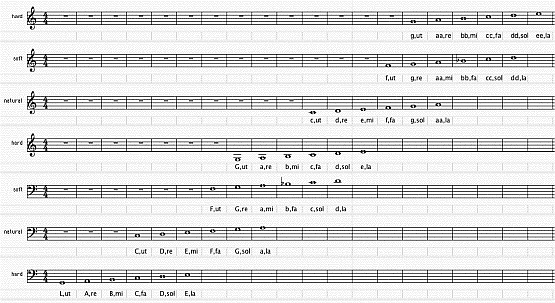hexachord
1. Postulated intermediate stage in ancient Greek music
A postulated intermediate stage in the expansion from the enharmonic tetrachord to the full octave scale.
If the pyknon of the lower tetrachord (hypaton) is split into two microtones while the upper (meson) one is undivided, a plausible form of the hexachord is produced.
This process works similarly for the chromatic and the diatonic genera assuming that they both were derived from pentatonic precursors of the whole tone and minor third variety. This definition of hexachord is not the same as the one of the medieval theorist Guido D'Arrezzo. (see below)
2. Medieval solmization system of Guido d'Arezzo
As defined by Guido d'Arezzo, a scale segment consisting of six tones, each tone being assigned a "solfege" syllable, with the syllables, and intervals between "steps", having the following pattern:
ut re mi fa sol la ^ ^ ^ ^ ^ Tone Tone Semitone Tone Tone
In the system constructed by Guido, hexachords were possible on three pitch-levels, with "ut" on what we would today call "C" (the "natural" hexachord), "F" (the "soft" hexachord), and "G" (the "hard" hexachord). This corresponds to a moveable "ut" centered on the "natural-ut", "natural-fa", and "natural-sol", as follows:
ut re mi fa sol la
ut re mi fa sol la
ut re mi fa sol la
Notes were generally named by using all applicable syllables, i.e., "G" sol-re-ut.
I have deliberately left letter-names out of this diagram, to give a sense of the difficulty encountered by ancient and medieval theorists in discussing musical pitches without the use of mathematics or alphabetical ordering.
During later centuries, however, letters were used more and more, in conjunction with the Guidonian syllables, beginning with Γ (gamma) as the lowest note, continuing upward with the capital letters A, B, C, D, E, F, G, then with the lower-case letters a, b, c, d, e, f, g, then finally with doubled lower-case letters aa, bb, cc, dd, ee, with ee considered to be the highest note in the gamut until about 1300. Below is a musical illustration of the entire Guidonian gamut.

So listed here in descending order, the entire gamut was referred to thus:
ee la dd la sol cc sol fa bb mi bb fa aa la mi re g sol re ut f fa ut e la mi d la sol re c sol fa ut b mi b fa a la mi re G sol re ut F fa ut E la mi D sol re C fa ut B mi A re Γ ut
Note the existence of the two different B's in both octaves: b fa and b mi, and bb fa and bb mi, because the letter "b" was used to refer to both what we today call b-natural and b-flat.
3. Hexachords in 12-tone serial method
A development of 12-edo serial theory (Schoenberg's "12-tone method"), in which the 12 notes of the row are divided in half, to form two series of 6 notes each, called hexachords. This procedure was used as early as 1917 by Schoenberg in his draft of Die Jakobsleiter, and published by Hauer in 1922 in his article "Sphärenmusik".. Schoenberg stated that he got the idea from Scriabin.
Usually, the hexachord pair exhibits similarities of interval structure (i.e., transposition) or other serial properties such as retrograde or inversion, or various combinations of all of them.
The tonalsoft.com website is almost entirely the work of one person: me, Joe Monzo. Please reward me for my knowledge and effort by choosing your preferred level of financial support. Thank you.
